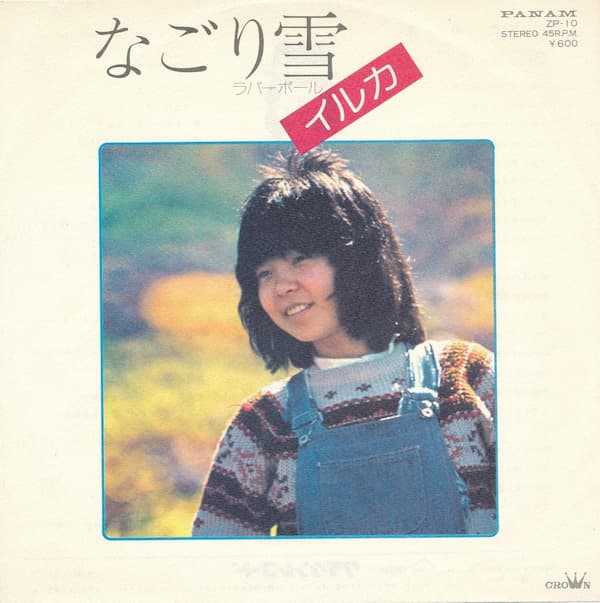曲の紹介

- 曲名:なごり雪
- アーティスト:イルカ / かぐや姫
- 作詞・作曲:伊勢正三
- レーベル:PANAM(日本クラウン)
- リリース:1974年3月12日
- 概要:1974年3月12日かぐや姫の4枚目のアルバム「三階建の詩(さんかいだてのうた)」に収録された。
その後、1975年11月5日イルカがシングルがカバー・バージョンをシングルとして発表し、徐々に売り上げを伸ばし、オリコンチャート1位を記録する大ヒットとなった。
- 記事引用元:
- なごり雪 -Wikipedia
- イルカ(歌手)-Wikipedia
- かぐや姫 -Wikipedia
- 伊勢正三 -Wikipedia
曲について
「なごり雪」は、伊勢正三がつくり、イルカがカバーしヒットしました。
イルカは当初、この曲を歌うことに躊躇していましたが、伊勢正三からの強い勧めにより歌うことになりました。彼女の柔らかい歌声と感情豊かな表現が、この曲の魅力を一層引き立てています。
歌詞の内容は、駅のプラットホームで、別れて東京を去っていく彼女を見送るシーンを描いています。
恋人の彼女を見送るホームには、春だというのに雪がちらついています。
まるで、二人の別れを惜しむかのように。
まさに誰もが胸にかかえているような、青春の苦い思い出のシーンが浮かんできます。
まさに時代を超える名曲だと思います。
汽車を待つ君の横で
ぼくは時計を気にしてる
季節はずれの雪が降ってる
「東京で見る雪はこれが最後ね」と
さみしそうに 君がつぶやく
なごり雪も 降る時を知り
ふざけすぎた 季節のあとで
今 春が来て 君はきれいになった
去年よりずっと きれいになった
なごり雪/ イルカより
曲の動画
- イルカ / なごり雪 (シングルミックス) Official Audio
- なごり雪 (1976 イルカ・ライヴ コンプリート)
- かぐや姫 (Kaguyahime) – なごり雪 (Official Audio)
- イルカ / なごり雪 (with 南 こうせつ・伊勢正三) 「イルカ with Friends Vol.10 (2014)」
アーティストの紹介
イルカ
- アーティスト:イルカ(本名:神部 としえ)
- 誕生日:1950年12月3日
- 出身地:東京都中野区
- 活動時期:1970年 –
- 公式サイト:イルカ公式サイト
アーティストの軌跡
「イルカ」は、日本を代表する女性シンガーソングライターです。
彼女は、1970年代から1980年代にかけてのニューミュージックシーンを象徴するアーティストの一人です。
彼女の楽曲は、優しい歌声と叙情的な歌詞が特徴で、時代を超えて多くの人々に愛されています。
イルカのキャリアの中で最も知られている曲のひとつに「なごり雪」があります。
この曲はもともと「かぐや姫」のメンバーだった伊勢正三が作詞・作曲した作品で、イルカのバージョンが1975年にリリースされると大ヒットしました。
冬から春への移り変わりと共に感じる別れの情景を描いたこの歌は、世代を超えて愛され続けており、イルカの代名詞とも言える存在です。
音楽活動のほかにも、イルカはテレビやラジオへの出演、エッセイの執筆など多方面で活躍しています。
彼女のエッセイは、日常の中で感じたことや音楽に対する思い、自然への愛情などを率直に綴っており、多くの読者に共感を呼んでいます。
彼女は環境問題や動物保護活動にも積極的に取り組んでおり、社会貢献にも力を注いでいます。
彼女の穏やかで温かみのある歌声は、多くの人々にとっての癒しとなり、彼女が作る楽曲は喜びや悲しみを共に分かち合えるような温もりを持っています。
かぐや姫
- アーティスト:かぐや姫(第2期「南こうせつとかぐや姫」)
- ・南こうせつ(ボーカル&ギター)、伊勢正三(ボーカル&ギター)、山田パンダ(ボーカル&ベース)
- 活動場所:日本
- 活動時期:1971年-1975年
- 公式サイト:日本クラウン紹介ページ
アーティストの軌跡
1971年9月シングル「青春」で再デビュー(第1期は1970年にデビュー)し、1972年3月テレビアニメ主題歌「海のトリトン」を須藤リカ/南こうせつとかぐや姫でシングルリリースしました。
1973年9月シングル「神田川」をリリースし、最終的に160万枚を売り上げ、大ヒットとなりました。
その年のNHK紅白歌合戦の出場依頼が来ましたが、歌詞に出てくるクレパスが製品名であり、クレヨンへの変更を求められて出場を辞退しています。
1975年4月12日東京神田共立講堂で解散コンサートを最後に解散しました。
その後、南こうせつと山田パンダはソロとして、伊勢正三は風を結成し音楽活動を続けています。
伊勢正三
- アーティスト:伊勢正三
- 誕生日:1951年11月13日
- 出身地:日本大分県津久見市
- 活動時期:1970年-
- 公式サイト:ISE SHOZO OFFICIAL SITE
アーティストの軌跡
大分県の高校で音楽部の先輩だった南こうせつが、東京で先に「かぐや姫」を結成していましたが、大学に入った伊勢正三を誘い、山田パンダを加え「かぐや姫」を再結成しました。
「22才の別れ」はかぐや姫のアルバム「三階建の詩」のために作られた2曲のうちの1曲でした。
(他の1曲は「なごり雪」)
シングルの要望もありましたが、結局かぐや姫では発売されず、後の「風」としてシングルとして発売されました。ただし、風のアルバム「風ファーストアルバム」には収録されていません。
この曲は、あくまで「かぐや姫」時代の曲なのでアルバムには入れなかったようです。
この当時、青春を過ごした人にとってこの「22才の別れ」という曲は、まさに青春そのもののシンボルのような曲ではないでしょうか?
ほんとうに、このアコースティック・ギターのイントロを聴くだけで、涙がでるのは私だけでしょうか?
ディスコグラフィの紹介「イルカ」
シングル
- 7インチシングル:
- 1974年 あの頃のぼくは B 春
- 1975年 風にのせて B 陽だまりの中で
- 1975年 なごり雪 B ラバーボール
- オリコン最高4位、1976年度年間チャート11位
- 1976年 君は悲しみの B おりこうさんにはならないよ
- 1976年 片想いの少女へ B おこられ人生
- 1977年 雨の物語 B 我が愛犬
- オリコン最高16位、1977年度年間チャート34位
- 1978年 サラダの国から来た娘 B 月下美人の咲く夜に
- 1979年 海岸通 B つばめの帰る家
- オリコン最高24位、1979年度年間チャート92位
- 1980年 十九の春に B モズのために
- 1980年 夜明けのグッドバイ B 10年前の君の街
- 1981年 FOLLOW ME B 私だけの子守唄
- 1981年 枯葉のシーズン B 不思議が眠る君
- 1982年 渚にて B 恋はカラフル
- 1982年 きみのマーチ B 鳥の記憶
- 1983年 LOST LOVE B 風にのせて
- 1985年 もう海には帰れない B 梅花
- 1986年 海のゆりかご B どうぶつ通り夢ランド
- 1987年 雨上がりの夏 B いつまでもNice Friends
- 1989年 悲しみの証明 B 嫉妬(ジェラシー)
- 1989年 迎えに行く朝 B いつだって愛してる
- 8cmCD:
- 1989年 時の子守唄 B 想い出をそばに置いて
- 1990年 1 きよしこの夜 2 ハッピー・クリスマス 3 いつの日か二人でクリスマスを 4 ホワイト・クリスマス
- 1991年 1 終恋 コープこうべ イメージソング 2 未来の君へ
- 1991年 1 あいふたたび 2 二匹の魚 (Fish&Fish)
- 1993年 1 女はつらいよ 2 子守熊のように
- 1996年 1 傘の雫 2 心の砂時計
- 1998年 1 花一輪 2 星の長距離電話
- 1999年 1 地上の愛 美川憲一&イルカ初のデュエットシングル 2 地上の愛(カラオケ)3 地上の愛(イルカ歌入りカラオケ)4 地上の愛(美川憲一歌入りカラオケ)
- 1999年日1 光のとびら 2 心配させたい帰り道
- CD:
- 2001年 1 あなたの胸に 2 真冬の天使~さっぽろバージョン~
- 2001年 1 旧友再会
- 2002年 1 夢ひとり 2 祈り
- 2002年 1 なごり雪(2002年ver.)2 なごり雪(韓国語ver.)3 鳥の記憶(リミックスver.)
- 2003年 1 真冬の天使 2 真冬の天使(メッセージ入り)3 あるあるアルファベット星人 ポンキッキーズ21 4 P-Kiesアルファベットの歌 ポンキッキーズ21
- 2007年 1 まあるいいのち 2 まあるい地球は誰のもの
- 2008年 1 いつか見る虹〜”モルダウ”から〜 みんなのうた6・7月 2 夢の散歩
アルバム
- 1975年 イルカの世界
- 1975年 夢の人
- 1977年 植物誌
- 1977年 ボヘミアの森から
- 1978年 ちいさな空
- 1979年 いつか冷たい雨が
- 1980年 我が心の友へ
- 1981年 FOLLOW ME
- 1982年 JULIA
- 1983年 ノエルの不思議な冒険
- 1983年 LOOP CHILD
- 1985年 Heart Land
- 1986年 ESSAY
- 1987年 私の動物アルバム
- 1989年 けさらんぱさらん
- 1990年 Delfina
- 1990年 Noël ファンタスティックな冬物語
- 1991年 OLD FRIEND
- 1993年 ラピスの丘で~Lapis lazuli~
- 1996年 おさなごころ-1995番目の春に想う-
- 1998年 羅針盤の上
- 1999年 ウツツノユメ
- 2004年 私の動物アルバム『・・・そして今も』
- 2005年 Any Key OK!!
- 2007年 はるじょおん ひめじょおん
- 2012年 ほのぼの倶楽部
- 2017年 惑星日誌〜今、伝えたいこと〜
ベストアルバム
- 1996年 KANON
- 2002年 こころね
- 2006年 イルカ・ベスト
- 2010年 森羅万象~イルカ セレクトベスト~
- 2011年Jasmine&Rose
ライブアルバム
- 1976年 イルカライブ
- 1980年 あしたの君へ
- 1984年 BIG CHALLENGE
*引用:イルカ (歌手)-Wikipedia
